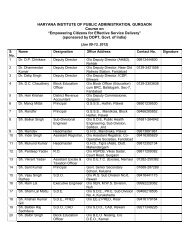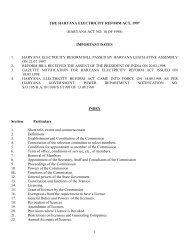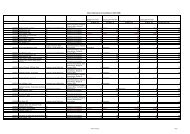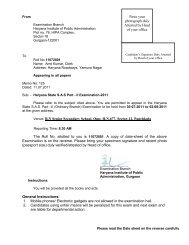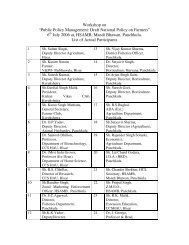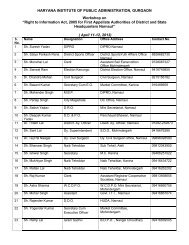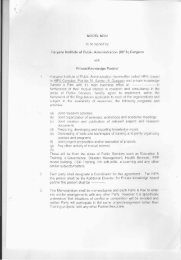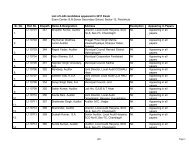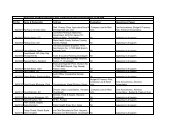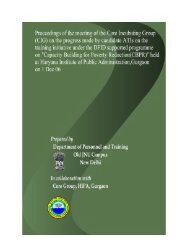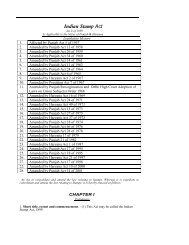Introduction to Computers - HIPA
Introduction to Computers - HIPA
Introduction to Computers - HIPA
You also want an ePaper? Increase the reach of your titles
YUMPU automatically turns print PDFs into web optimized ePapers that Google loves.
<strong>Introduction</strong> <strong>to</strong> <strong>Computers</strong><br />
Computer System<br />
A computer is a fast electronic device that processes the input data<br />
according <strong>to</strong> the instructions given by the user and provides the desired<br />
information as an output.<br />
A complete computer installation including the central processing unit,<br />
the peripherals such as hard disk drives, floppy disk drives, moni<strong>to</strong>r, printer,<br />
mouse and operating system which are designed <strong>to</strong> work and interact with<br />
each other and with the user is called a computer system.<br />
Components of a computer system<br />
A computer system has following three main components:<br />
(a) Input/ Output Unit<br />
(b) Central Process Unit<br />
(c) Memory Unit<br />
INPUT<br />
CU<br />
ALU<br />
OUTPUT<br />
MEMORY<br />
Secondary Memory<br />
Input/output Unit: We know that the computer is a machine that processes<br />
the input data according <strong>to</strong> given set of instructions and gives the output.<br />
Before a computer does processing, it must be given data and instructions.<br />
After processing, the output must be displayed or printed by the computer.<br />
The unit used for getting the data and instructions in<strong>to</strong> the computer and<br />
displaying or printing output is known as an Input/output Unit (I/O Unit).<br />
1
The Input Unit is used <strong>to</strong> enter data and instructions in<strong>to</strong> a computer.<br />
There are many peripheral devices, which are used as input/output units for<br />
the computer. The most common form of input device is known as a<br />
terminal. A terminal has a electronic typewriter like device, called keyboard<br />
along with a display screen, called Visual Display Unit (VDU) or moni<strong>to</strong>r.<br />
Keyboard is the main input device while moni<strong>to</strong>r can be considered both as<br />
an input as well as an output device. There are some other common input<br />
devices like mouse, punched card, type, joystick, scanner, modem etc., which<br />
are explained in later part of this chapter. Moni<strong>to</strong>r, printer and plotter are the<br />
main peripheral devices used as output units for the computer.<br />
Central Processing Unit: Central Processing Unit (CPU) is the main<br />
component or “brain’ of a computer, which performs all the processing of<br />
input data. Its function is <strong>to</strong> fetch, examine and then execute the instructions<br />
s<strong>to</strong>red in main memory of computer. In microcomputers, the CPU is built on<br />
a single chip or Integrated Circuit (IC) and is called as Microprocessor. The<br />
CPU consists of following distinct parts:<br />
1. Arithmetic Logic Unit (ALU): The arithmetic and logic unit of CPU is<br />
responsible for all arithmetic operations like addition, subtraction,<br />
multiplication and division as well as logical operations such as less then,<br />
equal <strong>to</strong> and greater than. Actually, all calculations and comparisons are<br />
performed in the arithmetic logic unit.<br />
2. Control Unit (CU): The control unit is responsible for controlling the<br />
transfer of data and instructions among other units of computer. It is<br />
considered as a “Central Nervous System” of computer, as it manages<br />
and coordinates all the units of computer. It obtains the instructions from<br />
the memory, interprets them and directs the operation of the computer. It<br />
obtains the instructions from the memory, interprets them and directs the<br />
operation of the computer. It also performs the physical data transfer<br />
between memory and the peripheral device.<br />
3. Registers: Registers are the small high speed circuits (memory<br />
locations) which are used <strong>to</strong> s<strong>to</strong>re data, instructions and memory<br />
2
addresses (memory location numbers), when ALU performs arithmetic<br />
and logical operations. Registers can s<strong>to</strong>re one word of data (1 word = 2<br />
bytes & 1 byte = 8 bit; details of BITS AND BYTES are discussed in later<br />
part of this chapter) until it is overwritten by another word. Depending on<br />
the processor’s capability the number and type of registers vary form one<br />
CPU <strong>to</strong> another. Registers can be divided in<strong>to</strong> six categories viz. General<br />
Purpose Registers, Pointer Registers, Segment Registers, Index<br />
Registers, Flags Registers and Instruction Pointer Registers, depending<br />
upon their function. The detailed functions of each and every register are<br />
beyond the scope of this book.<br />
4. Buses: Data is s<strong>to</strong>red as a unit of eight bits (BIT stands for Binary<br />
Digit i.e. 0 or 1) in a register. Each bit is transferred from one register <strong>to</strong><br />
another by means of a separate wire. This group of eight wires, which is<br />
used as a common way <strong>to</strong> transfer data between registers, is known as a<br />
bus. In general terms, bus is a connection between two components <strong>to</strong><br />
transmit signal and Address Bus. The data bus is used <strong>to</strong> move data,<br />
address bus <strong>to</strong> move address or memory location and control bus <strong>to</strong> send<br />
control signals between various components of a computer.<br />
5. Clock: Clock is another important component of CPU, which<br />
measures and allocates a fixed time slot for processing each and every<br />
micro-operation (smallest functional operation). In simple terms, CPU is<br />
allocated one or more clock cycles <strong>to</strong> complete a micro-operation<br />
(smallest functional operation). In simple terms, CPU is allocated one or<br />
more clock cycles <strong>to</strong> complete a micro-operation. CPU executes the<br />
instructions is synchronization with the clock pulse.<br />
The clock speed of CPU is measured in terms of Mega Hertz<br />
(MHz) or Millions of Cycles per second. The clock speed of CPU varies<br />
from one model <strong>to</strong> another in the range 4.77 MHZ (in 8088 processor) <strong>to</strong><br />
66 MHz (in Pentium).CPU speed is also specified in terms of Millions of<br />
Instructions Per Second (MIPS) or Million of Floating Point Operations Per<br />
Seconds (MFLOPS).<br />
3
Memory Unit: Memory Unit is an important component of a computer<br />
system, which is used <strong>to</strong> s<strong>to</strong>re the data, instructions and information before,<br />
during and after the processing by ALU. It is actually a work area (physically<br />
a collection of integrated circuits) within the computer, where the CPU s<strong>to</strong>res<br />
the data and instructions. It is also known as a Main/Primary/ Internal<br />
Memory. It is of following three types:<br />
(a) Read Only Memory (ROM pronounced as “Ra-om”)<br />
(b) Random Access Memory (RAM pronounced as “R-aem”)<br />
(c) Complementary Metal Oxide Semiconduc<strong>to</strong>r Memory (CMOS)<br />
(a) Read Only Memory: Read Only Memory is an essential<br />
component of the memory unit. We know that the computer, being a<br />
machine, itself has no intelligence or memory and requires the<br />
instructions, which are given by man. Whenever the compute is switched<br />
on, it searches for the required instructions. The memory, which has<br />
these essential instructions, is known as Read Only Memory (ROM). This<br />
memory is permanent and is not erased when system is switched off. As<br />
appears with its name, it is read type of memory i.e. it can be read and<br />
only and not be written by user/programmer. The memory capacity of<br />
ROM varies from 64 KB TO 256 KB (1 Kilobyte= 1024 bytes) depending<br />
on the model of computer.<br />
ROM contains a number of programs (set of instructions). The most<br />
important program of ROM is the Basic Input Output System (BIOS,<br />
pronounced as “bye-os”), which activates the hardware (physical<br />
components of computer) such as keyboard, moni<strong>to</strong>r, floppy disk etc. in<br />
communicating with the system and application software (set of<br />
instructions or programs)<br />
There are many types of ROM available for microcomputers like<br />
Mask ROM, PROM, EPROM, EEPROM and EAPROM. Mask ROM is the<br />
basic ROM chip. In this type of ROM, the information is s<strong>to</strong>red at the time<br />
of its manufacturing. So, it cannot be altered or erased later on. PROM<br />
4
stands for Programmable Read Only Memory. In this type of ROM, the<br />
information is s<strong>to</strong>red by programmes after its manufacturing. It cannot be<br />
altered or erased later on. EPROM stands for Erasable Programmable<br />
Read Only Memory. It is similar <strong>to</strong> PROM, but its information can be<br />
erased later on by ultra violet light and it can be reprogrammed. EEPROM<br />
stands for Electrically Erasable Programmable Read Only Memory. It is<br />
similar <strong>to</strong> EPROM, but using a high voltage current can erase its<br />
information. EAPROM stands for Electricity Alterable Read Only Memory.<br />
As compared <strong>to</strong> EPROM and EEPROM, the information s<strong>to</strong>red in<br />
EAPROM can be altered later.<br />
(B) Random Access Memory: Random Access Memory (RAM) is<br />
another important component of Memory Unit. It is used <strong>to</strong> s<strong>to</strong>re the data<br />
and instructions during the execution of programme. Contrary <strong>to</strong> ROM,<br />
RAM is temporary and is erased when computer is switched off. RAM is<br />
read write type of memory and, thus can be read and written by<br />
user/programmer. As it is possible <strong>to</strong> randomly use any location of this<br />
memory, therefore, this memory is known as random access memory.<br />
The memory capacity of RAM varies from 640 KB <strong>to</strong> several megabytes<br />
(1 Megabyte= 1024 KB) with different models of PC.<br />
There are two types of RAM used in PC –Dynamic and Static RAM. The<br />
information s<strong>to</strong>red in Dynamic RAM (DRAM) has <strong>to</strong> be refreshed after<br />
every few milliseconds otherwise it is erased. DRAM has higher s<strong>to</strong>rage<br />
capacity and is cheaper than Static RAM. The information s<strong>to</strong>red in Static<br />
RAM need not be refreshed, but it remains stable as long as power supply<br />
is provided. SRAM is costlier but has higher speed than DRAM.<br />
(b) Complementary Metal Oxide Semiconduc<strong>to</strong>r Memory:<br />
Complementary Metal Oxide Semiconduc<strong>to</strong>r (CMOS) memory is used <strong>to</strong><br />
s<strong>to</strong>re the system configuration, date, time and other important data. When<br />
computer is switched on, BIOS matches the information of CMOS with the<br />
peripheral devices and displays error in case of mismatching.<br />
5
Computer Memory<br />
Primary Memory<br />
Secondary Memory<br />
RAM ROM Floopy<br />
Disk<br />
Hard<br />
Disk<br />
CD ,<br />
DVD<br />
Pan<br />
Drive<br />
Hardware and Software components of a Microcomputer:<br />
In <strong>to</strong>day’s computer industry, a wide variety of hardware components<br />
are available for microcomputers. Managers must be aware of the working<br />
and uses of different hardware components, so that they can make good<br />
decisions about purchase of computer systems. The hardware components<br />
of microcomputer can be classified in<strong>to</strong> following types:<br />
(A) Motherboard<br />
(B) Input Devices<br />
(C) Output Devices<br />
(D) S<strong>to</strong>rage Devices<br />
(E) Cards<br />
(F) Ports and Cords<br />
(G) Power Supply<br />
The following table clarifies the meaning of the components:<br />
Sr.<br />
No.<br />
1.<br />
2. Input<br />
Devices<br />
Name Meaning Examples<br />
Motherboard Motherboard, also<br />
called as System<br />
Board, is the most<br />
important hardware<br />
component of a<br />
microcomputer.<br />
Input devices are<br />
used <strong>to</strong> input data,<br />
information and<br />
instructions in<strong>to</strong> the<br />
RAM.<br />
A motherboard contains the CPU<br />
chip, Memory chip (ROM and<br />
RAM chips), I/O interface,<br />
expansion slots and many other<br />
logic circuits.<br />
Keyboard, Trackball, Light Pen,<br />
Touch Screen, Joystic, Digitiser,<br />
Scanner, Optical Mark Reader<br />
(OMR), Optical Character Reader<br />
(OCR), Bar Code Reader,<br />
6
3. Output<br />
Devices<br />
4. S<strong>to</strong>rage<br />
Devices<br />
Output devices are<br />
hardware components<br />
which are used <strong>to</strong><br />
display or print the<br />
processed<br />
information.<br />
To S<strong>to</strong>re the data,<br />
instructions and<br />
information. There are<br />
two types of S<strong>to</strong>rage<br />
devices Primary<br />
Memory and<br />
Secondary Memory<br />
5. Cards Cards are the printed<br />
circuit boards used <strong>to</strong><br />
hold the chips<br />
(integrated circuits)<br />
6. Ports and<br />
Cords<br />
7. Power<br />
Supply<br />
The rear of a PC has<br />
many empty holes or<br />
external sockets<br />
called ports or<br />
connec<strong>to</strong>rs.<br />
Cords are the cables<br />
used <strong>to</strong> plug in<strong>to</strong> the<br />
ports.<br />
Power Supply is<br />
considered as the<br />
‘Heart’ of a PC. Power<br />
supply is that<br />
important hardware,<br />
which provides the<br />
power source <strong>to</strong> a<br />
computer.<br />
Magnetic Ink Character<br />
Recognition (MICR), Voice-Input<br />
Devices.<br />
Moni<strong>to</strong>r, Printer, Plotter<br />
Floppy Disk, Hard disk, Compact<br />
Disk, Magnetic Tape, Video Disk,<br />
Magne<strong>to</strong> Optical Drive , DVD<br />
RAM/ROM Disk.<br />
Video Card, Sound Card, I/O<br />
Card, Controller Card and Memory<br />
Card.<br />
Serial Port, Parllel Port, Game<br />
Port and Video Port.<br />
Keyboard Cords, power cords,<br />
moni<strong>to</strong>r cords and printer cords.<br />
UPS, CVT<br />
(B) SOFTWARE<br />
Software relates <strong>to</strong> a set of Program. The software control the<br />
computer hardware parts and makes them operational. In other words, it<br />
governs the operations of a computer system.<br />
(a) System Software<br />
(b) Application Software<br />
7
Sr. Name Definition Examples<br />
No.<br />
1. System Software, which are<br />
Software required <strong>to</strong> control the<br />
working of hardware and<br />
aid in effective execution of<br />
a general user’s application<br />
are called system software.<br />
Software<br />
Transla<strong>to</strong>rs,<br />
For e.g. Windows, Linux,<br />
MAC OS<br />
2. Application<br />
Software<br />
Software which are required<br />
for general and special<br />
purpose applications like<br />
database management,<br />
word<br />
processing,<br />
accounting etc, are called<br />
as application software.<br />
For e.g. MS-Office<br />
(i) System Management<br />
Software<br />
(Operating Systems )<br />
(ii) System Development<br />
(Language<br />
Application<br />
Genera<strong>to</strong>rs, CASE Tools)<br />
(iii) System Software Utilities<br />
such as Windows, Linux<br />
(I) General Purpose<br />
Application Software<br />
(Database Management<br />
Packages, Word Processors,<br />
Spreadsheets, Office<br />
Au<strong>to</strong>mation Packages)<br />
(II) Special Purpose<br />
Application Software<br />
(Desk<strong>to</strong>p<br />
Multimedia,<br />
Applications)<br />
Publishing,<br />
Business<br />
Accessing Computer Memory:<br />
Primary memory can be directly accessed by the CPU but<br />
secondary memory cannot be accessed directly. Data from<br />
secondary memory is first transferred <strong>to</strong> the primary memory and<br />
then from the primary memory <strong>to</strong> the CPU.<br />
Processing<br />
Primary Memory<br />
Secondary Memory<br />
8
Pic<strong>to</strong>rial Representation of Hardware and Software<br />
Hardware<br />
System Software<br />
Application Software<br />
User<br />
9
Virus<br />
A computer virus is a computer program that can copy itself and infect a computer.<br />
The term "virus" is also commonly but erroneously used <strong>to</strong> refer <strong>to</strong> other types of<br />
malware, including but not limited <strong>to</strong> adware and spyware (Spyware is a type of<br />
malware that can be installed on computers, and which collects small pieces of<br />
information about users without their knowledge. The presence of spyware is typically<br />
hidden from the user, and can be difficult <strong>to</strong> detect.) Typically, spyware is secretly<br />
installed on the user's personal computer programs that do not have the reproductive<br />
ability. A true virus can spread from one computer <strong>to</strong> another (in some form of<br />
executable code) when its host is taken <strong>to</strong> the target computer; for instance because a<br />
user sent it over a network or the Internet, or carried it on a removable medium such as<br />
a floppy disk, CD, DVD, or USB drive. [2]<br />
Types of Viruses<br />
There are many types of computer viruses:<br />
• File virus : Most viruses fall in<strong>to</strong> this category. A virus attaches itself <strong>to</strong> a file,<br />
usually a program file.<br />
• Boot sec<strong>to</strong>r virus : These viruses infect floppy and hard drives. The virus<br />
program will load first, before the operating system.<br />
• Macro Virus : This is a new type of virus that use an application's own macro<br />
programming feature <strong>to</strong> distribute themselves. Unlike other viruses, macro<br />
viruses do not infect programs; they infect documents.<br />
• Virus Hoax : Although there are thousands of viruses discovered each year,<br />
there are still some that only exist in the imaginations of the public and the press<br />
- known as virus hoaxes. These viruses hoaxes DO NOT EXIST, despite<br />
The Types Of Computer Viruses<br />
There are six broad categories or types of computer viruses:<br />
1. Boot Sec<strong>to</strong>r Virus<br />
2. File Infection Virus<br />
3. Multipartite Virus<br />
4. Network Virus<br />
5. E-mail Virus<br />
6. Macro Virus<br />
Boot Sec<strong>to</strong>r Viruses<br />
Viruses that aim at the boot sec<strong>to</strong>r of a hard drive are infecting a very crucial<br />
component of the boot process. The boot sec<strong>to</strong>r holds critical information that<br />
controls the hard drive and also the part of the operating program that is in<br />
10
charge of the whole boot process. These types of computer viruses go a long<br />
way <strong>to</strong>ward the assurance they will be successful in their mission by absolutely<br />
loading in<strong>to</strong> the system memory while the boot cycle is starting.<br />
Unlike other viruses the boot virus does not affect files, instead it goes after the<br />
drive itself on which the virus is saved and this is part of the reason that it is no<br />
longer as big a threat as it used <strong>to</strong> be. Since the advent of CDs and DVDs and<br />
the drives that carry them it is not possible <strong>to</strong> infect the programs that they carry.<br />
In the days of floppy drives the virus could spread quite quickly from computer <strong>to</strong><br />
computer via the disks but since it is not possible <strong>to</strong> infect a CD or DVD this virus<br />
has become almost a non threat. Another reason this types of computer viruses<br />
have become less common is that now operating systems stand guard over the<br />
boot sec<strong>to</strong>r and that makes it very hard for the virus <strong>to</strong> have any effect.<br />
File Virus<br />
File viruses are coded so that they will attach themselves <strong>to</strong> exe files,<br />
compressed files like zip files and driver files. The can be set in<strong>to</strong> actions when<br />
the program they are attached <strong>to</strong> is started. Then after the virus is set in<strong>to</strong> motion<br />
it will attach itself <strong>to</strong> other programs and system files and start along its intended<br />
path for which it was written. So you see it is a two prong approach. First<br />
depending on the types of computer viruses it will duplicate and then go about its<br />
intended mission. The virus will search through the programs in the system and<br />
find places <strong>to</strong> infect with the code and then it will activate when that program is<br />
run next time. It will continue <strong>to</strong> duplicate until it is all over the computer and<br />
probably any computer that is attached <strong>to</strong> the original system.<br />
Often these viruses will harbor special code that causes them <strong>to</strong> be activated<br />
when certain events take place. The event often is a date or some other trigger<br />
event that is easily defined on any computer system you may have.<br />
Multipartite Viruses<br />
That which has been termed the multipartite virus are the types of computer<br />
viruses that are both a file virus and a boot sec<strong>to</strong>r virus. They enter the<br />
computer via various sorts of media and then embed themselves in the system<br />
memory. They then go in<strong>to</strong> the hard drive and infect the boot sec<strong>to</strong>r. Once<br />
installed in the boot sec<strong>to</strong>r these types of computer viruses infect executable files<br />
and spread themselves in the system.<br />
This is another virus that has past its prime for various reasons but in times past<br />
these types of computer viruses were responsible for many infections because<br />
they combined characteristics of two different viruses in<strong>to</strong> one.<br />
11
Network Viruses<br />
A virus that is especially made for networks is uniquely created <strong>to</strong> quickly spread<br />
throughout the local area network and generally across the internet as well. Most<br />
of the time is moves within shared resources like drives and folders. Once it finds<br />
entry in<strong>to</strong> a system it will search for vulnerable computers in the network and<br />
likewise infect that system and do the same again and again always on the hunt<br />
for new vulnerable systems.<br />
E-Mail Viruses<br />
Most of the time a e-mail virus is one of those types of computer viruses that is<br />
generally a macro virus and it will multiply itself by seeking out the other contacts<br />
in a e-mail address book and then send itself <strong>to</strong> those addresses in hopes that<br />
they will activate the virus <strong>to</strong>o. Thus it spreads over and over again exponentially.<br />
There are even times an email virus can spread by only previewing it in the mail<br />
client. One that was very successful in spreading worldwide was the ILOVEYOU<br />
virus and it was destructive <strong>to</strong>o.<br />
Macro Viruses<br />
Macro viruses as the name implies, will infect files of programs that use macros<br />
in the program itself. The most common of these are the Microsoft Office files<br />
created in Excel spreadsheets, Word documents, Access databases, Powerpoint<br />
presentations and these type of files from AmiPro and Corel Draw and others.<br />
These types of computer viruses are programmed using the language that the<br />
application understands and not in the language of the operating system thus<br />
they are operating in a way that is independent of the operating system so it can<br />
infect any kind of system be it Mac, PC or even Linux just as long as the<br />
computer is running the application that understands the macro virus. As the<br />
macro language has become more and more powerful the threat of these types<br />
of computer viruses has graduated <strong>to</strong> more critical types of computer viruses.<br />
These viruses have been around since 1995 and the first was found <strong>to</strong> infect<br />
Microsoft Word but now have moved <strong>to</strong> other programs and they number in the<br />
thousands.<br />
One should always be on the lookout for these types of computer viruses and<br />
should take every precaution <strong>to</strong> avoid them. Be ever watchful of every file you<br />
open or else you may be looking for my next hub on how <strong>to</strong> remove these types<br />
of computer viruses.<br />
12
How <strong>to</strong> create a folder<br />
1. Select the location where you want <strong>to</strong> create a folder for e.g Desk<strong>to</strong>p, hard<br />
disk<br />
2. Click on Mouse Right But<strong>to</strong>n<br />
3. Go <strong>to</strong> New- folder(Click mouse left but<strong>to</strong>n)<br />
4. Type the name of folder<br />
Select the<br />
location<br />
Click<br />
mouse right<br />
but<strong>to</strong>n<br />
Go <strong>to</strong><br />
New<br />
Go <strong>to</strong> Folder and<br />
click left but<strong>to</strong>n of<br />
mouse<br />
Type the<br />
Name of<br />
folder<br />
Click<br />
outside<br />
the box<br />
13



